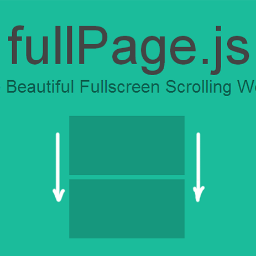fullpage.js
Connect fullpage.js with Webflow to get custom scroll hijacking, involving handling momentum scrolling, keyboard navigation, touch gestures, and history state.

How to integrate fullpage.js with Webflow
fullpage.js disables native browser scrolling and uses CSS transforms instead of scrollTop values. This means Webflow's scroll-into-view animations won't trigger by default. The library also changes scroll behavior in the Webflow Editor, which can make the interface difficult to use for content editors working in the CMS.
fullpage.js integrates with Webflow through code embed elements and custom code features, giving you control over scrolling behavior, section transitions, and navigation patterns. fullpage.js also provides a JavaScript API for controlling scroll behavior, while Webflow offers CMS APIs for dynamic content integration.
Embed fullpage.js with Code Embed elements
Add fullpage.js to specific pages using Webflow's custom Code Embed element. Use this method when you need full-screen scrolling on select pages like portfolio showcases or product launches without affecting your entire site.
Drag an Embed element onto your canvas and insert the complete integration code, including CSS links, HTML structure, and JavaScript initialization. You need a container div with ID fullpage and nested section elements with class section.
Here’s how to implement it:
- Add the
fullpage.cssstylesheet link in your embed element head - Include the
fullpage.jsscript from a versioned CDN for reliability - Structure your HTML with a wrapper
divIDfullpagecontaining section elements with classsection - Initialize fullpage.js with your configuration options like
autoScrolling: trueandnavigation: true
Note: Webflow enforces a 50,000 character limit per embed element. If your implementation exceeds this, host the fullpage.js files externally and reference them via URLs.
Add site-wide custom code
Inject fullpage.js across your entire site through custom code fields. Use this when multiple pages need full-screen scrolling functionality with consistent configuration.
Open Site Settings > Custom Code and add your CSS and JavaScript file references in the head code section. Place the initialization script in the footer code section using DOMContentLoaded event listeners for proper timing.
Key configuration options include:
scrollBar: true- Restores native scrolling for Webflow animation compatibilityscrollOverflow: true- Allows scrollable content within sectionsautoScrolling: false- Alternative approach for full Webflow animation supportresponsiveWidth: 768- Disables fullpage.js on mobile viewports
Note: Site-wide implementation affects all pages by default. Add conditional logic to your initialization script if you need fullpage.js active on specific pages only.
Implement page-level custom code
Apply fullpage.js to individual pages through your Page Settings > custom code options. Page-level code takes precedence over site-wide settings, letting you override global configurations or add functionality to specific pages.
Use this method for:
- Product landing pages requiring unique scrolling behaviors
- Portfolio sections with custom transition effects
- Campaign pages with specific navigation requirements
Build dynamic fullpage.js sections with the Webflow CMS API
Use the Webflow CMS API to fetch collection items and dynamically generate fullpage.js sections. This approach works when you need to create portfolio showcases, product galleries, or blog post layouts where each collection item becomes a fullpage.js section.
Initialize fullpage.js after retrieving CMS data through the API. You can retrieve collection items and structure the returned data for fullpage.js sections. Fetch your collection items, map them to section HTML, inject the sections into your #fullpage container, then initialize the library.
Keep in mind that all Webflow API requests require Bearer token authentication according to Webflow's authentication documentation.
What you can build
fullpage.js enables full-screen scrolling for portfolios, product showcases, and structured content sites with section-based navigation.
- Portfolio sites with full viewport sections per project: Configure fullpage.js with
scrollHorizontally: trueto add horizontal image galleries within sections. Traditional page scrolling is disabled, so users navigate between sections using scroll gestures or keyboard. Structure requires one.sectionelement per project with nested.slideelements for galleries. Use conditional loading to maintain Editor usability. - Product pages with full viewport per feature: Initialize with
autoScrolling: trueandnavigation: truefor section dots. Add horizontal sliders within sections by nesting.slideelements under.sectionelements. ConfigureresponsiveWidth: 768to disable fullpage.js on mobile viewports where standard scrolling is expected. - Company sites with structured story segments: Set
data-anchorattributes on section elements for URL-based navigation (example:#about,#mission,#team). Users can bookmark or share specific sections. Configureanchors: ['about', 'mission', 'team']in initialization to support this behavior. - Web-based presentations with multi-directional navigation: Combine
scrollHorizontally: truewith nested.slideelements under.sectionelements. AddcontrolArrows: truefor navigation arrows between slides. Disable on small screens withresponsiveHeight: 600to restore normal scrolling when viewport height is insufficient.
Frequently asked questions
fullpage.js disables native browser scrolling and uses CSS transforms instead of actual
scrollTopvalues. Webflow animations detect scroll position changes, but fullpage.js never changes the scroll position - it transforms sections instead.Fix this by initializing fullpage.js with
scrollBar: trueorautoScrolling: falseto restore native scrolling behavior. Alternatively, use fullpage.js callbacks likeafterLoad,onLeave, andafterSlideLeavefrom the fullpage.js methods documentation to manually trigger Webflow animations through CSS class manipulation when sections become active.fullpage.js hijacks scroll behavior in Webflow, making the interface unscrollable. This happens because fullpage.js captures all scroll events including those needed for Editor navigation.
Implement conditional loading that only activates fullpage.js on published sites. Check the hostname before initialization to prevent the library from running in Webflow when you're editing. This lets you work normally in the Editor while maintaining full functionality on your live site.
Yes. Fetch collection data through the Webflow CMS API before initializing fullpage.js. Use the
GET /collections/{collectionId}/itemsendpoint from the CMS items reference to retrieve your content, then build fullpage.js sections dynamically.Pre-load CMS data before fullpage.js initialization rather than fetching content on demand during section transitions. After updating CMS content through the API, use fullpage.js methods like
destroy()andreBuild()from the methods documentation to refresh the DOM structure.fullpage.js requires specific HTML structure and configuration. Standard Webflow navigation links don't automatically connect to fullpage.js sections.
Manually add data attributes to your sections using Webflow's custom attributes panel. Set
data-anchorattributes on each section element with unique identifiers, then specify anchors in your fullpage.js initialization withanchors: ['section1', 'section2', 'section3']. Create navigation links using these anchor names - fullpage.js will handle the section navigation automatically when visitors click links like#section1or#section2.

Description
fullpage.js is a JavaScript library that creates full-screen scrolling websites with section-based navigation. It provides vertical scrolling with automatic section navigation, horizontal sliders within sections, CSS3-based transitions, built-in navigation bars with tooltips, anchor link support for URL-based targeting, lazy loading for media elements, and a comprehensive callback system. The library works across all modern browsers and supports full-screen content presentation for portfolios, product pages, and corporate websites.
This integration page is provided for informational and convenience purposes only.

ConnectMagic
You can integrate Connect Magic with Webflow to automate email marketing without code, enabling you to sync form submissions, track cart abandonment, and trigger behavioral campaigns.

Google Meet
Connect Google Meet with Webflow using integration platforms like Zapier to automate meeting scheduling from form submissions, display upcoming events in your CMS, and manage video conference workflows

Azwedo
Connect Azwedo's development tools with AI features to Webflow through one-time export workflows and file storage integration.

Finsweet Webflow Hacks
Connect Finsweet Webflow Hacks integrate through Webflow's native code embed features using JavaScript and jQuery snippets.

WooRank
Connect WooRank with Webflow through an official marketplace app to provide real-time SEO analysis, Core Web Vitals monitoring (LCP, FID, CLS), and downloadable PDF reports within Webflow.

Finsweet Components
Finsweet Components provides JavaScript components that integrate with Webflow Designer through a marketplace app and custom code embeds.

EX.CO
Connect EX.CO with Webflow to add interactive video players and monetize content through custom embed codes.

Finsweet Class Adder
You can connect Finsweet Class Adder to manage CSS classes dynamically in Webflow using interactions, CMS data, and visual workflows.

Lottieflow
Connect Lottieflow with Webflow to add customizable, lightweight JSON animations directly to your site.


